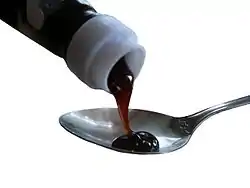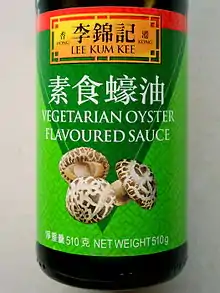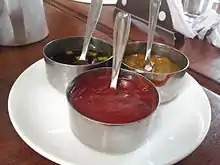Oyster sauce
Oyster sauce describes a number of sauces made by cooking oysters. The most common in modern use is a viscous dark brown condiment made from oyster extracts,[1][2][3] sugar, salt and water thickened with corn starch. Some versions may be darkened with caramel, though high-quality oyster sauce is naturally dark.[4] It is commonly used in Chinese, Thai, Malay, Vietnamese and Khmer cuisine.
| Oyster sauce | |||||||||||||
|---|---|---|---|---|---|---|---|---|---|---|---|---|---|
 | |||||||||||||
| Traditional Chinese | 蠔油 | ||||||||||||
| Simplified Chinese | 蚝油 | ||||||||||||
| Literal meaning | oyster oil/liquid | ||||||||||||
| |||||||||||||
| Alternative Chinese name | |||||||||||||
| Traditional Chinese | 蚵油 | ||||||||||||
| |||||||||||||
Development
Oyster sauce was invented accidentally by Lee Kum Sheung in Nanshui, Zhuhai, Guangdong Province, China, in 1888.[5][6] He ran a tea stall that sold cooked oysters. One day, Lee was cooking oysters as usual, but he lost track of time and left them to simmer until he smelled a strong aroma. Lifting the lid of the pot, he was delighted to find the normally clear oyster soup had turned into a thick, brownish sauce with an astonishingly delicious taste. Soon he started selling his newly invented seasoning, which turned out to be a hit with the locals. He founded Lee Kum Kee to promote oyster sauce and other Chinese sauces and condiments to all corners of the world.
Production
Traditionally, oyster sauce is made by slowly simmering oysters in water until the juices caramelise into a thick, brown, intensely flavourful sauce. Today, many shortcuts have been made to create a similar flavour more quickly and at reduced cost. Oyster sauces today are usually made with a base of sugar and salt and thickened with corn starch. Oyster extracts or essences are then used to give flavour to the base sauce. Other ingredients, such as soy sauce and MSG, may also be added to deepen the flavour and add colour. The quality of the oyster sauce will greatly affect the flavour.[7]
Oyster sauce is made manually in the traditional method. Some oyster sauce manufacturers have improved the process to produce oyster sauce en masse with automation. The oyster extracts are mixed with sugar, corn starch and the like with the weighing and mixing processes powered by an automatic electronic system before uniform blending on the automatic production line. The mixed ingredients are cooked in a sealed automatic production system at high temperature by a computerized system. The cooked sauce is transferred to the filling system through sealed pipelines, and reaches the market shelves only after multiple rounds of inspection.
Culinary use
Oyster sauce adds a savory flavour to many dishes, making it an ideal choice for flavouring meat and vegetables. The sauce is a staple for much Chinese family-style cooking. It is commonly used in noodle stir-fries, such as chow mein. It is also found in popular Chinese-American dishes such as beef with stir-fried vegetables. Oyster sauce can also be used as a topping for some dishes.
Since its early stage of development, oyster sauce has been widely popular with Cantonese chefs as a traditional umami rich condiment.
Until now, the applications of oyster sauce are no longer restricted to Cantonese cuisine. Be it the well-balanced Shandong cuisine, the spicy hot Sichuanese cuisine, or the seafood and red stewing-dominated Jiangsu and Zhejiang cuisine, oyster sauce plays a part in enhancing the flavours without hampering the authenticity of taste. It brings out the umami flavour in the best delicacies while adding texture and flavour to everyday dishes, which makes it a condiment of choice indispensable for both professional or home kitchens.
Oyster sauces are well known for its magic of “bringing out the umami taste in flavourful foods” while “adding flavour to bland ingredients”, serving as versatile condiment ideal for umami-inducing, flavour enhancement, colour-enriching, brightness-adding and sauce-retaining for different cuisines.
The popularity of oyster sauce in the international market has lifted its application in different cuisines apart from Chinese.
Dishes that may use oyster sauce include Crab in oyster sauce, Kai-lan, Buddha's delight, Hainanese chicken rice, Cashew chicken, Lo mein, Cha siu baau, Har gow, Kai yat sai, Wonton noodles, and Daikon cake.
Varieties

"True" oyster sauce of good quality should be made by condensing oyster extracts, the white broth produced by boiling oysters in water. This opaque broth, similar to the colour of clam juice found in supermarkets, is then reduced until a desired viscosity has been reached and the liquid has caramelized to a brown colour.[8] No other additives, not even salt, should be added to the sauce, since the oysters should provide all the savoury flavour. However, this method is prohibitively expensive.
Many modern oyster sauces are thickened with cornstarch, flavoured with oyster essence or extract[2][9] and darkened with caramel.[4]
Vegetarian oyster sauce
Vegetarian oyster sauce prepared from mushrooms, often oyster mushrooms or shiitake mushrooms, is also popular and generally lower in price. It may contain more taste enhancers if less mushroom extract is used to reduce costs.
Non-MSG oyster sauce
Most of the oyster sauces available on the market contain added monosodium glutamate (MSG). In recent years MSG-free varieties can also be found.[10]
European oyster sauce
In 19th century French and English cooking, "oyster sauce" referred to a variant of sauce blanche flavoured with oysters, using a base of milk and melted butter rather than purely reducing the oysters by cooking.[11][12] The white sauce version was moistened with cream, whereas in brown oyster sauce, the cream was replaced with gravy.[13] Common recipes using the sauce included "Steak and oyster sauce", documented as early as 1806,[14][15][16][17] and "Cod and oyster sauce".[18] This sauce was still being eaten in Australia in the 1970s.
Health
In 2001, the United Kingdom Food Standards Agency found in tests of various oyster sauces and soy sauces that 22% of samples contained a chemical called 3-MCPD (3-monochloropropane-1,2-diol) at levels considerably higher than those deemed safe by the European Union. About two thirds of these samples also contained a second chemical, called 1,3-DCP (1,3-dichloropropanol), which experts advise should not be present at any levels in food. Both chemicals have the potential to cause cancer, and the Agency recommended that the affected products be withdrawn from shelves and avoided.[19][20]
The joint Australia New Zealand Food Authority (ANZFA) said it had taken emergency action to amend its food standards code to set a limit for 3-MCPD in soy sauce of 0.02 milligrams per kilogram, in line with European Commission standards that came into force in the EU in April 2002.
References
- Wing Yip Oyster Sauce Ingredient List:1.3% oyster essence
- The Times, 22 January 1981; Cook Accidentally on purpose
- BBC.co.uk Essence or extract
- BigOven Food DictionaryOyster sauce
- Bartlett, Jessica (25 April 2016). "Family of Chinese Oyster Sauce Empire Gives $21 Million to Harvard". Boston Business Journal. Archived from the original on 13 April 2018.
- Hayes, Janice Leung (6 May 2018). "Made in Hong Kong: The History of Lee Kum Kee's Oyster Sauce – So Good it is Served in Space". South China Morning Post. Archived from the original on 5 June 2018.
- Moncel, Bethany. "What is Oyster Sauce?". About.com. Retrieved 15 September 2013.
- "Essence or extract". Archived from the original on 11 March 2010.
- "bbc.co.uk".
- Mrs Beeton's Household Management, recipe 492 "Oyster Sauce", p. 224 (1861).
- Ude, Louis Eustache. The French Cook, p.293, Publisher Carey, Lea & Carey, 1829.
- Charles Elmé Francatelli The modern cook T.B. Peterson and Brothers, 1846
- The Ipswich Journal; 4 January 1806; Friday's Post
- The Times, 17 August 1815; Mendicity
- The Times, 30 March 1831 Police
- The Times, 22 October 1835 "On Monday afternoon..."
- "Fashions for August" Liverpool Mercury 9 August 1833
- "Food.gov.uk press release soysauce".
- "Chart with five mentions of affected oyster sauces". Archived from the original on 5 August 2009.
